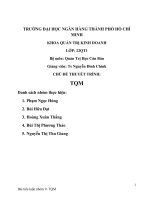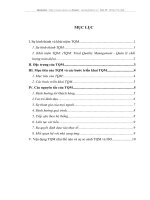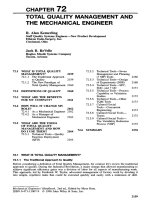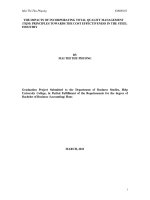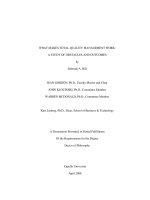the impacts of incorporating total quality management (tqm) principles towards the cost effectiveness in the steel industry
Bạn đang xem bản rút gọn của tài liệu. Xem và tải ngay bản đầy đủ của tài liệu tại đây (494.07 KB, 91 trang )
Mai Thi Thu Phuong E0600101
i
THE IMPACTS OF INCORPORATING TOTAL QUALITY MANAGEMENT
(TQM) PRINCIPLES TOWARDS THE COST EFFECTIVENESS IN THE STEEL
INDUSTRY
BY
MAI THI THU PHUONG
Graduation Project Submitted to the Department of Business Studies, Help
University College, in Partial Fulfillment of the Requirements for the degree of
Bachelor of Business (Accounting) Hons
MARCH, 2011
Mai Thi Thu Phuong E0600101
2
Declaration
I hereby declare that the graduation project is based on my original work except
quotations and citations which has been duly acknowledged. I also declare that it has not been
previously or concurrently submitted for any other course/degree at Help University or other
institutions. The word count is 14,304 Words.
Mai Thi Thu Phuong E0600101
3
Acknowledgement
First of all, I am grateful to Mr Pham Duc Hieu , the professor who gave lots of useful
advices as well as materials for this thesis. And I would like to say thank to productions,
marketing, and accounting managers and all of employees of 50 manufacturing companies,
who allowed and assisted me to collect all of necessary information to finish this thesis. My
thesis can not be finished without your supports. It is a great lucky when I can get responses
from you.
Mai Thi Thu Phuong E0600101
4
Table of Content
Declaration 2
Acknowledgement 3
Abstract: 5
CHAPTER I: Introduction 7
1.1. Introduction about the topic 7
1.2 Need for Research 9
1.2.1 Research question 11
1.2.2 Research objective 11
1.3 Elements of the Research 12
CHAPTER II: Literature review 15
2.1 History of WCM and TQM 15
2.1.1 History of WCM and TQM general review 18
2.1.2 TQM concepts 22
2.2 Judgments about the TQM in general 28
2.2.1. TQM appreciations 29
2.2.2 TQM criticism 33
2.3 Impacts of TQM on decision making process of manager as well as its influences on the
organizations 36
CHAPTER III: RESEARCH METHODOLOGY 39
3.1 Research objective 39
3.2 Research strategy 40
3.3 Research hypothesis 40
3.3.1 Impact of Total Quality Management (TQM) on ABC costing method 42
3.3.2 Impact of Total Quality Management (TQM) on Plant Performance 44
3.3.3 Impact of TQM on plant performance: A mediation mechanism 46
3.4 Measurement of variables 50
3.4.1 Dependent variables (Plant performance) 50
3.4.2 Independent variables 50
3.4.2.1 Total quality management (TQM) implementation 50
3.4.2.2 Plant-level control variables 54
3.5 Research methodology 55
3.6 Data sources and sampling 57
3.6.1 Sample selection 57
3.6.2 Data collection method 57
3.7 Limitation of research 58
CHAPTER IV: ANALYSIS 61
4.1 Results Analysis 61
4.1.1 Percentage method 61
4.1.2 Results analysis for hypothesis 1 to 3 67
4.1.2.1 Impact of Activity-based Costing on Total Quality Management 67
4.1.2.2 Impact of Total Quality Management (TQM) on plant performance 67
4.1.2.3 Impact of TQM on plant performance: A mediation mechanism 75
4.2 Discussion 76
CHAPTER V: CONCLUSION 78
5.1 Implication of research 78
5.2 Conclusion 78
Mai Thi Thu Phuong E0600101
5
THE IMPACTS OF INCORPORATING TOTAL QUALITY MANAGEMENT (TQM)
PRINCIPLES TOWARDS THE COST EFFECTIVENESS IN THE STEEL INDUSTRY
BY
MAI THI THU PHUONG
MARCH, 2011
Supervisor: Mr PHAM DUC HIEU
Abstract:
Based on the results o f previous studies, choosing a suitable managing method is really
important. However, manufacturing practices have different kind of methods such as: Just-In-
Time method (JIT), Total Quality Management (TQM), Formal Continuous Process
Improvement, Competitive Benchmarking, and Self-directed Teams. Hence, it is quite difficult
for managers to choose. Comparing to other manufacturing method, Total Quality
Management (TQM) can be considered as the most suitable method to adopt since it brings lots
advantages to manufacturers. That is why the author wants to focus on this method more. In
fact, TQM has direct and positive impacts on the costs allocation and quality improvements.
However, there are not many researches mentioned about the indirect impacts of TQM.
Therefore, in this thesis, indirect influences of TQM will be clarified with the supporting of
ABC costing method. The same as World Class Manufacturing, costing methods include
different kinds like traditional costing method, variable method, throughput costing method,
and ABC costing method. Compare to others, ABC not only inherent good characters of
previous method but also adapts rapidly to the changes of business environment. As a result,
Mai Thi Thu Phuong E0600101
6
when managers can adopt and combine both TQM and ABC, the performance of
manufacturing firms will be enhanced twice. Vietnamese business environment changes
quickly. Therefore, the author thinks carrying a survey might be a good way to conclude about
the reality of the most suitable management method that Vietnamese enterprisers adopted
recently.
Mai Thi Thu Phuong E0600101
7
CHAPTER I: Introduction
1.1. Introduction about the topic
In general, for one cost accounting method,
there are many manufacturing practices can be adopted in
an organization. However, until now, only some researchers
focus on which manufacturing methods should apply for
what cost accounting method. Specific in Vietnam, a lot of
changes occurs especially when most of companies turn
into a new trend in using the cost accounting method from
2000. Instead of adopting the traditional method, Activities
Based Costing method or ABC seems more workable and
precisely. This does not mean all of these companies use
the same manufacturing practices. Based on different
situations as well as strengths and weaknesses of various
companies, each of companies can find the most suitable
manufacturing practice to adopt.
In order to have a clear and objective point of
view about the relationship between cost accounting
method which are traditional costing method and ABC
method and WCM, a survey will be implemented.
20companies will be chosen to carry this survey. After
receiving all of answers from these companies, we can see
Mai Thi Thu Phuong E0600101
8
which kind of WCM is adopted more for which costing
methods.
This study in nature can be considered as a
conclusion about the most popular manufacturing practices
which are adopted in most of companies in the steel
industry. Upon this survey result, companies can figure out
what method is adopted most and whether the current
method that they use is effective and efficient. In case they
see the advantages of another manufacturing practice, they
can decide whether they should change and use a new one.
During this thesis, some questions will be
focused such as:
- What is WCM and TQM
- Advantages and disadvantages of TQM
- What are current manufacturing practices applied now
especially in Vietnam
- How many companies use WCM until now
- How many of them adopt the Total Quality
Management (TQM) as a manufacturing practice.
Mai Thi Thu Phuong E0600101
9
In the next part, some term will be added and
explained to ensure that the readers can follow all of ideas
that the author want to share.
1.2 Need for Research
As mentioned in the introduction, there are
various types of costing methods for example: traditional or
absorption costing method, variable costing methods,
Activities based costing method (ABC), throughput costing
method, and lean costing methods. Each method carries
both advantages and disadvantages. To analysis careful
about each method will require lots of time and capacities
since documents for some methods was destroyed. As a
result, in this thesis, only traditional accounting method and
ABC methods, the most popular costing methods, are
concentrated and analyzed.
It is quite difficult to say which method between
traditional and ABC method is better. Therefore,
advantages as well as disadvantages of each one should be
shown. According to this, readers can understand why in
different circumstances, different methods will be adopted.
For example, in the beginning of the industrial century,
traditional costing method is still the most popular. But
now, when the global trend dominated and international
transactions developed, traditional or absorption costing
Mai Thi Thu Phuong E0600101
10
method slowly starts showing its inconveniences. ABC
method was invented and become more and more suitable
with the current accounting environment. After a short
time, it is widely adopted because of lots of strengths.
WCM refers to the way that the managers can
manage the manufacturing process of a specific company.
There are different kinds of manufacturing practices such as
Just-In-Time method (JIT), Total Quality Management
(TQM), Formal Continuous Process Improvement,
Competitive Benchmarking, and Self-directed Teams.
According to different researchers, each method can be the
best way to manage the manufacturing process if the
managers know how to use the strength of them. For many
companies in the World, Just in time can be considered as
the most popular method. However, in Vietnam, TQM is
the most suitable one. Therefore in this paper, the author
will define and analyze the advantages and disadvantages
this method only.
Mai Thi Thu Phuong E0600101
11
1.2.1 Research question
There are two questions that the author wants to
focus on this thesis are what TQM is and how the TQM
affects on the performance of organizations. Normally,
most people think that only costing method can affect the
operation of organizations. However, in fact, besides
costing method, TQM is also a factor which decides the
success of the organization as a whole.
1.2.2 Research objective
In order to achieve the expectation of the author
about this thesis, doing surveys and calculating the statistics
will be used mostly during the project. As mentioned
above, questions will be covered in 3 categories: plant
characteristic, cost accounting method and WCM. And
three hypotheses will be designed based on:
+ Impacts of TQM on the cost accounting methods
+ Impacts of the cost accounting methods on the plant
characteristics
+ Impacts of TQM on the performance of
organizations
Mai Thi Thu Phuong E0600101
12
It is quite easy to see that the characteristics of a
plant can decide the costing method as well as WCM that
they need. This means there is a relationship between
costing method and WCM. The statistics number can proof
this relation.
Although this can show the evidence for the
interaction between WCM and cost accounting, this
research still faces some limitations such as the quantity of
companies which are involved in the survey process,
changing in the business environment as well as changing
in the internal operation of companies. Therefore, the result
of this survey might be difficult to conclude if the author
implements the survey on a large sample with different
types of business enterprisers.
1.3 Elements of the Research
In order to reach the decision about which
manufacturing practices is adopted most for traditional
method and ABC costing method, 20 companies in steel
industry will be picked up. These companies will answer a
survey with specific question as below:
- Plant characteristics
Mai Thi Thu Phuong E0600101
13
- Cost accounting method that they adopted before 2000
and after 2000
- WCM method
Depending on each question, the answer can
include various options.
Plant characteristics will focus on size, plant age, mix
and volume, discrete, and downsize. Size can be
defined into 5 options based on the number of the
employees in each plant such as 1-less than 100; 2-100
to 249; 3-250 to 499; 4-500 to 999; and 5-more than
1000 employees. The second factor-plant age will
separate these companies into 5 categories depending
on the years that companies start-up like 1-less than
5years; 2-5 to 10 years; 3-11 to 20years; and 4- more
than 20years. The rest factors also will be class different
companies based on different key point. This will be
mentioned more detailed in the survey and the thesis.
Cost accounting method can be divided into 2 periods-
before and after 2000. For some companies, traditional
method is still applied now. But for others, ABC
method is considered from the early of the 20
th
century.
The third trend is that before 2000 they used traditional
Mai Thi Thu Phuong E0600101
14
method then they change into ABC method after 2000.
Each company has their own thinking in choosing the
method to adopt. There are 3 options will be applied in
this part: 0-no implementation; 1-plant to implement;
and 2-extensive implementation.
The same as cost accounting method, TQM
manufacturing method will be judged based on three
options: 0-no implementation; 1-plant to implement;
and 2-extensive implementation. Different company
will have different decisions on the leverage of TQM
that adopted in their business.
From the survey responses and statistics
number, the author can conclude some points of view about
the relationship between the cost accounting method and
WCM.
Mai Thi Thu Phuong E0600101
15
CHAPTER II: Literature review
2.1 History of WCM and TQM
In general, WCM can be defined as a set of
concepts, principles, policies and techniques to manage and
operate a manufacturing company. This can be considered
as an improvement process started from before the World
War II with an achieved result of the Japanese
manufacturing resurgence. Time by time, this is enhanced
and harmonized with different ideas of Japanese in various
fields such as automotive, electronics and steel companies
to create the core competitive edge. In other words, this
continually enhances the effectiveness and efficiencies in
quality, cost, lead time, flexibilities as well as customers’
service.
In order to implement WCM, manufacturing
companies needs time and personnel to be familiar with
WCM. Different WCM method requires different factors.
As a result, for most of managers, WCM is a process-driven
approach. It usually includes all of activities as below:
Make-to-order
Streamlined flow
Small lot sizes
Mai Thi Thu Phuong E0600101
16
Families of parts
Doing it right the first time
Cellular manufacturing
Total preventive maintenance
Quick changeover
Zero Defects
Just-in-time
Variability reduction
High employee involvement
Cross functional teams
Multi-skilled employees
Visual signaling
Statistical process control
Most of companies which are applied WCM
strategies not only focus on improving the operational
hierarchy but also concern about the method to limit the
wasted and save the costs as well as resources. This will
lead to a higher productivity with a lower costs and time
consuming. Moreover, by this way, the burden of selling
inventory will not be a problem since the delivery speed is
improved every day. In stead of focusing on the results of
performance, managers concern about the process and
method of working to judge. Teamwork defeats functional
Mai Thi Thu Phuong E0600101
17
and hierarchical trends and becomes the dominated trend in
the world.
For many people, WCM is still mistaken with
standards of quality and image such as Volkswagen and
Rolex. And it also leads to changes in working place. In
fact, middle and lower managers refused to adopt WCM
since they want to maintain the traditional working style.
Therefore, to adopting WCM, involvement of employees
should be required at highest level. Moreover, to adapt with
the needs of quickly changeover, shorter time consuming
and higher operational flexibility, capitalization should be
concerned as the most important issue of manufacturing
companies. More alternatives will be taken into account to
save investment costs and increase the applicability of
results.
However, if WCM can be applied probably and
precisely, a new dimension will be created with high
quality products, shorter delivering time, and higher
inventory turn over.
Mai Thi Thu Phuong E0600101
18
2.1.1 History of WCM and TQM general
review
As mentioned above, WCM is invented before
the World War II and improved time by time. This includes
many methods such as just-in-time manufacturing (JIT),
process improvement continuously, total quality
management (TQM), competitive benchmarking, and
worker autonomy by need of self-directed of work teams.
However, in this thesis, the author will focus only on the
TQM as the most popular and developed method.
In the period from 1927 to 1932, some
experiments of Elton Mayo’s Hawthorne about the
delegation power to workers leads to a wave for a new
trend. This is the first time, a person can proof that the
participation of workers in decision making process can
increase the productivity. Hawthorne carried his study on
his plant of Western Electric Company based on some
factors such as: lighting levels, workday lengths, and rest
period lengths. And he figured out that all of these factors
can affect the level of productivity. For example, workers
can work more effective and increase the productivity when
the light is brighter and in contrast. Another researcher
Mai Thi Thu Phuong E0600101
19
Walter Shewhart also invented control charts to reflect the
interaction between the level of involvement of employees
in decision making process and productivity improvement
during the 1930s. These changes remarked a huge change
in the management accounting.
Following the inventions from 1930s, the ISO
9001 standards were born in the World War II as a result of
satisfying the requirements for the war. It pushed
standardization, statistical control, and best manufacturing
practices developed a bigger movement.
In 1950s, statistical methods and quality
management techniques was delivered to Japanese with the
supports from Edward Deming and Dr Juran while the first
book about Total Quality Control was written and become
background to develop many WCM theories later. In 1954,
self actualization needs of Abraham Maslow defined
clearly the needs of employees which can be considered as
the motivations to increase the effectiveness and
efficiencies of productivity. This shows that higher level
workers will focus on higher needs. Based on these,
managers can design suitable prizes to encourage the
workers contribute to the companies and enhance the
Mai Thi Thu Phuong E0600101
20
productivity easily. Sometimes, small gifts can have the
same effect as valuable presents. Therefore, managers can
do both purposes: motivating the workers while
maintaining effective capitals to companies.
In 1960s, new leadership model with theory X
and theory Y of Douglas McGregor made the WCM
becomes more and more various. This declared that the way
managers access and motivate the employees can be also a
factor which can enhance the productivity. Theory X states
that workers need some enforcement from managers to do
their works while theory Y focuses on creating the trust
between manager and employees. Based on this relation,
employees will be involved in the problem solving as well
as decision making process. When the employees think
they are a part of the companies, they will try harder and
contribute more to the companies as a natural result.
During 1970s to 1980s, the phrase of Total
Quality Control was shaped by Japanese and this also the
key philosophy which helped Japan became the world
quality leader. Other countries also tried to access and
apply this new philosophy therefore the gaps between
countries became smaller and smaller. In fact in 1980s,
Mai Thi Thu Phuong E0600101
21
Japan still dominated the world quality at that time but
many countries especially US gained some core
competitive in quality leader for few products. In this
period, most of companies can see the benefits in increasing
productivity, WCM and TQM spread as wild fire.
However, lots of companies failed in adopting WCM and
TQM since they faced the resistances from their own
employees.
Although many companies refused to apply
WCM and TQM after seeing failures from earlier ones,
WCM and TQM still kept moving forward. And the period
of 1990s can be considered as the time for the evolution
century for WCM and TQM. New method with Lean
Manufacturing and Six Sigma was born and supported to
TQM. In order to make the different between companies
who applied TQM and who not applied TQM, a certificate
based on the ISO 9001 from World War II is adopted. An
award called Malcolm Baldridge National Quality Award
(MBNQA) was given to companies as an evidence for the
quality standards and the most outstanding quality
management practices.
Mai Thi Thu Phuong E0600101
22
In 2000s, other standards such as AS9100 for
aerospace, TS16949 for automotive, ISO 14001 for
environmental, TL9000 for electronics, and ISO 17025 for
laboratories was created as revised ISO 9001. This not only
focuses on the main content of ISO 9001 but also concerns
more on the business planning, quality management and
continuous improvement.
2.1.2 TQM concepts
In general, adopting TQM takes time and money
because of its complicated and various difficulties. There
are six activities which are included in TQM which are
customer central hierarchy, empowering employees,
exploring profits, reducing costs, continuously
improvement and management centered approach.
Implementing only one or few steps will not help
organizations reach their targets. Therefore, readers should
follow all of concepts to ensure that they have a right,
accuracy and precisely background about TQM
Mai Thi Thu Phuong E0600101
23
P
r
i
n
c
i
p
l
e
1
C
u
s
t
o
m
e
r
f
o
c
u
s
Organizations depend
on their customers and
therefore should
understand current and
future customer needs,
should meet customer
requirements and strive
to exceed customer
expectations.
P
r
i
n
c
i
p
l
e
2
L
e
a
d
e
r
s
h
i
p
Leaders establish unity
of purpose and
direction of the
organization. They
should create and
maintain the internal
environment in which
people can become
fully involved in
achieving the
organization's
objectives.
P
r
i
n
c
i
p
l
e
3
I
n
v
o
l
v
e
m
e
n
t
o
f
p
e
o
p
l
e
People at all levels are
the essence of an
organization and their
full involvement
enables their abilities to
be used for the
organization's benefit.
P
r
i
n
c
i
p
l
e
4
P
r
o
c
e
s
s
a
p
p
r
o
a
c
h
A desired result is
achieved more
efficiently when
activities and related
resources are managed
as a process.
P
r
i
n
c
i
p
l
e
5
S
y
s
t
e
m
a
p
p
r
o
a
c
h
t
o
m
a
n
a
g
e
m
e
n
t
Identifying,
understanding and
managing interrelated
processes as a system
contributes to the
organization's
effectiveness and
efficiency in achieving
its objectives.
P
r
i
n
c
i
p
l
e
6
C
o
n
t
i
n
u
a
l
i
m
p
r
o
v
e
m
e
n
t
Continual
improvement of the
organization's overall
performance should be
a permanent objective
of the organization.
P
r
i
n
c
i
p
l
e
7
F
a
c
t
u
a
l
a
p
p
r
o
a
c
h
t
o
d
e
c
i
s
i
o
n
m
a
k
i
Effective decisions are
based on the analysis of
data and information.
P
r
i
n
c
i
p
l
e
8
M
u
t
u
a
l
l
y
b
e
n
e
f
i
c
i
a
l
s
u
p
p
l
i
e
r
r
An organization and its
suppliers are
interdependent and a
mutually beneficial
relationship enhances
the ability of both to
create value.
Table 2.3: ISO 9000:2000
Principles for Quality Management
(www.iso.org)
The first factor can be considered as the
organizational orientations. In order to access and satisfy
the customers’ need, an internal culture and environment
are really important. Employees can not work and support
to each other if they have not shared any values. As a result,
sharing and demonstrating mutual trust, fairness, and
reliability among employees are essential. This will cancel
the barriers from the employees and help them closer.
When they feel freedom and openness, they will share and
Mai Thi Thu Phuong E0600101
24
contribute more to the companies. Therefore, the
productivity will be increased rapidly. To do this, manager
should take caring their own employees. Listening and
solve problems with them is the best way to create a unique
environment without fear and rigid. Mistakes that
employees made will be a lesson to them and they will have
experiences to face and solve the problems in the
correspondent circumstances. Instead of punishment,
educating employees becomes a favorable method of
managers. By this way, power will be delegated to
employees and future mistakes will be eliminated by
themselves.
As mentioned in the first factor, power
delegation or involvements of employees is a key to
increase the productivity effectively and efficiently.
Therefore the need for a flexibility system is increased fast.
Teamwork is more popular. Instead of thinking about
themselves, employees feel more freedom to share their
ideas as well as the responsibilities and duties. This helps
the solving problems process become easier and reduce the
time consuming as well as costs. Moreover, a team win is a
win for each person in that team. And managers know how
to judge the capability of each person based on the overall
Mai Thi Thu Phuong E0600101
25
score of the whole team. However, this only can be
achieved since the managers can create an ideal
environment when fear is removed from the workplaces
and employees are connected to each other by mutual trust,
fairness, and reliability. The role of managers in this
process is also essential. They should be open minded and
have visions to direct their employees grow and develop in
the right track. Power will not be delegated correctly if
managers are not willing to do this. As a result, managers
should provide a flexibility working system to ensure that
model can be improved continuously. But data should be
collected to a centre to enhance the reliability and precisely.
This will reduce the distractions from outside and helps the
decisions of employees become valuable.
The third factor refers to the profits that an
organizations can gain when adopting TQM. To meet the
visions, missions and goals of the whole organizations,
managers should use the systematic approach to implement.
Unlike carrying separate works, managers can connect and
provides an efficient plan to their employees. Since the
employees are trained in a sharing environment with higher
education, they will try and contribute their best to carry on
the plan of managers. As a result, the quality of products,
productivity and profitability are also increased. This can

